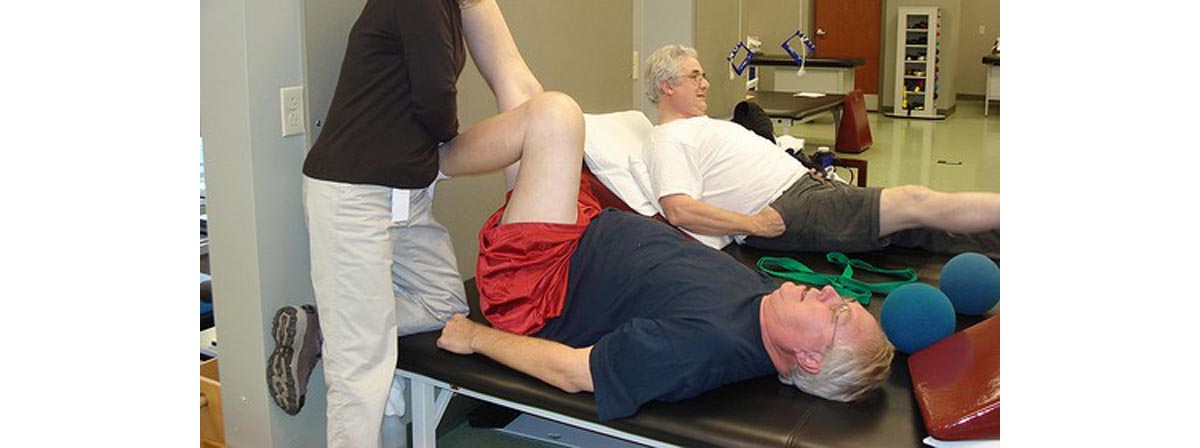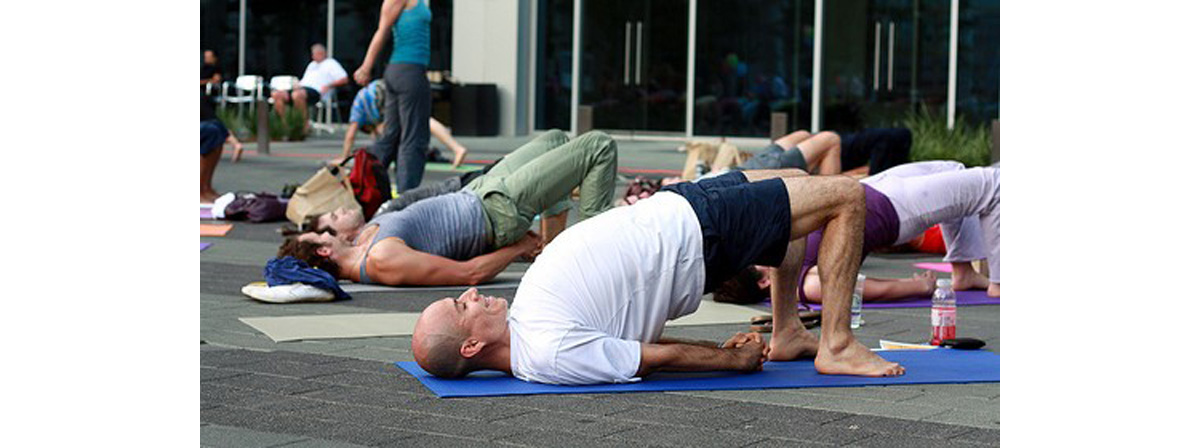After low back, neck and foot pain, knee pain is one of the most common and pervasive ailments there is. Knee pain plagues walkers, hikers, fishermen, joggers, soccer players, footballers, basketballers, skaters… and while everyone knows that exercise is the thing to do, the wrong kind of exercise can actually make your knee pain worse.

The first thing I want to do is distinguish between knee pain caused by wear and tear or inappropriate use and knee pain caused by arthritis or other similar chronic medical disorders. If your knee pain is arthritic, talk to a doctor and proceed with this or any other exercise plan with great caution. (That said, exercise can be effective for treating arthritis too; you just need your doctor's green light first!)
We’ll leave the feet out of it for now and focus on the most common causes of knee pain originating in the hip. The major muscles that affect the knee this way are the glutes, the iliotibial band and the quadriceps. The glutes form the buttocks, but some of the fibers of the glutes continue down the outside of the leg, playing a part in abducting the leg (which means moving it away from the center line) and in externally rotating the femur, turning the knee out from the center line. The iliotibial band, sometimes referred to as the ITB, is a tendinous muscle that connects the tibia, otherwise known as the shin bone, with the hip. It also tends to abduct and externally rotate the leg.
This can result from the hips or from overdepronation from the feet, but the problem can be partially addressed by working on the hips even if it originates in the feet.
All of this may feel like a little too much anatomy to swallow all in one go, but it’s really pretty simple: the leg has evolved to function with the knee more or less in a forward-backward plane. If it turns in or out, you’re going to have a problem, and pain will be the primary symptom.
Part of that problem comes from the fact that the knee doesn’t cope well with shearing force or rotation. Shearing force is when you push one part of a structure in one direction and another in the opposite direction. If it can, the structure will escape the force by falling over, or by bending. But the knee joint can’t bend in two places at once and it doesn’t bend at all sideways. Pressure applied in this way damages the ligament that holds the knee joint together, resulting in potential for damage down the line, and can injure the joint directly. The result, again, is pain.
Common Causes of Chronic Knee Injuries
A common way for knee pain to develop is through incorrect squatting. While the squat is a fairly simple movement, doing it with internally rotated femurs can cause torsion force between the femur and the bones of the lower leg – essentially, every time you squat, you’re tearing your knee apart. The downward force traveling through the buckled knee applies shear, too.
Another cause of chronic knee injuries is common to soccer and basketball players: sudden changes of direction characterize both sports, and the forces that travel through the knee when you change direction suddenly can be many times your body weight. If that happens and the angle of the knee is less than optimal, you can tear some tissues, or the high forces involved can make them tighten and swell, subtly deforming the movements of the knee and adding a chronic component to your acute injury.
Fixing Your Knee With Corrective Exercises
Whether your knee pain is caused by a traumatic injury, by overuse, by misuse or ‘other,’ you can still improve the situation with exercise. I’d like to group you, the reader, into one of two groups, based on whether or not you can still do a bodyweight squat to at least parallel without significant pain. Don’t try it if you’re afraid to try – trust the fear for now. If you can, you’re group 1; if you can’t, you’re group 2. This will determine which exercises will help you with your knee pain.

Group 1 exercises:
Split squats
Do these exercises in front of a mirror, or film yourself doing them. It’s not ‘working out’ – it’s practice. You’re trying to see what happens to your front knee and your hips as you move. If your front knee turns inward as you squat, your back hip rises or your front foot turns inward from the start, you may have found the problem, or this may be symptomatic. Either way, try to do a couple of split squats every day with your hips level and your front knee tracking in a straight line, neither in nor out.
Use these as a hip flexor loaded stretch too: raise the arm that corresponds to the back leg overhead, pushing your hips forward and down, to stretch out your hip flexor.
Squatting Hip Mobility
Hit a decent squat – parallel or deeper. Then turn your right foot out by pivoting on the heel until it’s at right angles to your left foot. The leg should follow naturally, opening up your hips. This exercise will be uncomfortable, but stop if it hurts!
It may take a while to get all the way there, so don’t rush; this exercise is about getting better and more pain free, and not not hitting some arbitrary flexibility goal. Next, start with your feet in a normal squat position and bend the knee in. This is referred to as ‘pronation’ and it should ideally end with the shin of the right leg on the floor. As you pronate your right leg you stretch the abductors on the right side and strengthen the abductors on the left side. Repeat on the left side, and watch yourself as you do this – don’t let the left side cave in to compensate!
Hip Abductor Stretch
Start sitting on the floor. Put one leg behind you and the outside of the front shin flat on the floor. Extend the back leg away from you as far as you can with your knee down and your heel up. Try to increase the distance between your knees and make the shin of your lower leg be at right angles to the rear leg. This is known to yoga practitioners as the ‘pigeon’ pose. As always, stop if it hurts!
Group 2 Exercises:
If you can’t squat to parallel or you don’t dare try, these exercises are for you.
Glute Bridges and Variations
The glutes don’t just extend the hips – they’re abductors too. If they are weak or underfiring, your knee stability will inevitably suffer. Lie on your back with your feet as close to your hips as you can manage, and drive down with your heels, raising your hips off the floor. The higher you can raise your hips, the better.
Abductor Stretch
Sit with your legs out in front of you. Put one ankle on top of the other knee, then drive that knee up, trying to keep the top leg’s shin level with the floor. You should feel a stretch along the outside of the top leg. Pain shouldn't be a part of the equation.
Adductor Stretch
Sit with your feet in front of you and your legs bent. With your arms inside your legs, grasp your ankles, with your elbows against the insides of your knees. Simultaneously pull your ankles towards you and apart, and push your knees apart with your elbows. This is a variation of the ‘butterfly’ stretch, that puts less stress on the knees.
Knee Extensions/Flexions
A mattress is good for doing these exercises on, but so is a pillow. Sit with your legs out in front of you, and put a pillow under the knee of one leg. First, drive down with the back of your knee, trying to press through the pillow and into the floor. Hold the hardest extension you can for a count of five. Next, flex the knee as much as you can, trying to catch the pillow between your heel and your butt. Once you can catch the pillow, try lifting it off the floor!
Hip flexor Stretch
Put one leg straight out behind you and the other with the foot flat on the floor in front of you, the knee bent at 90 degree angle. The angle of the back leg doesn’t need to be as much as you might think – we’re not doing the splits here. Raise the hand corresponding to the back leg overhead, feeling the stretch up the front of your leg, through the hip joint and into the spine.
Using these exercises should help to free up the tightness in the hips that can twist the leg and cause knee pain.
If, while attempting these exercises, you feel pain, it is best to speak to your doctor before continuing.
- Photo courtesy of GoingLikeSixty.com by Flickr : www.flickr.com/photos/25225730@N00/4176973005/
- Photo courtesy of adrian valenzuela by Flickr : www.flickr.com/photos/adrianv/4157275393/

